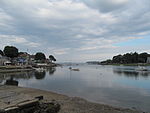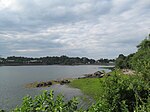Fort Pickering

Fort Pickering is a 17th-century historic fort site on Winter Island in Salem, Massachusetts. Fort Pickering operated as a strategic coastal defense and military barracks for Salem Harbor during a variety of periods, serving as a fortification from the Anglo-Dutch Wars through World War II. Construction of the original fort began in 1643 and it saw use as a military installation into the 20th century. Fort Miller (Fort Darby prior to the Civil War) in Marblehead also defended Salem's harbor from the 1630s through the American Civil War. Fort Pickering is a First System fortification named for Colonel Timothy Pickering, born in Salem, adjutant general of the Continental Army and secretary of war in 1795. Today, the remains of the fort are open to the public as part of the Winter Island Maritime Park, operated by the City of Salem.
Excerpt from the Wikipedia article Fort Pickering (License: CC BY-SA 3.0, Authors, Images).Fort Pickering
Winter Island Road, Salem
Geographical coordinates (GPS) Address Nearby Places Show on map
Geographical coordinates (GPS)
| Latitude | Longitude |
|---|---|
| N 42.526944444444 ° | E -70.867222222222 ° |
Address
Fort Pickering
Winter Island Road
01970 Salem
Massachusetts, United States
Open on Google Maps








